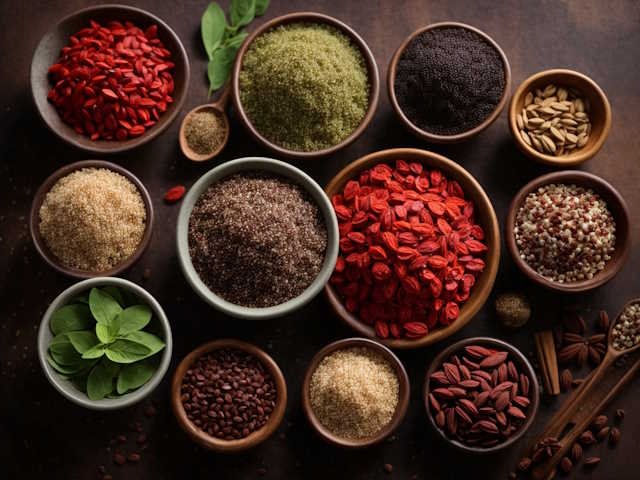In our busy lives, it’s important to care for our overall well-being. “Prana” is an age-old idea about our life energy. The food we eat can influence this energy. This article delves into the relationship between what we eat and our vitality, combining insights from old traditions and current research. Whether you’re deep into wellness or just beginning, this piece offers insights into enhancing your energy through thoughtful eating and nutrition & diet.
1. The Concept of Prana in Dietary Choices

In many ancient traditions, the concept of “prana” holds a special place. It’s more than just a term; it’s an understanding of the energy that animates us. Every breath we take, every beat of our heart, is a testament to this life force. But did you know that the foods we eat can have a direct impact on our prana?
Ayurveda, a traditional system of medicine from India, offers a unique lens through which we can view our dietary choices. It classifies foods into three categories based on their effects on our prana and overall well-being:
Sattvic Foods
Sattvic Foods are foods and beverages that are pure, clean, budget-friendly and wholesome with profound benefits. Contrary to some opinions, consuming them is believed to promote clarity, calmness, and a balanced mind, which are some of the key principles. A sattvic diet consists of fresh fruits, vegetables, and grains that haven’t been overly processed. A list of common foods can be found here.
For some tips on how to incorporate this diet into your daily life see our article on: Incorporating Sattvic Diets to Your Daily Life.
Rajasic Foods
A Rajasic diet consists of foods that stimulate the body and mind. While they can provide a burst of energy, they might also lead to restlessness or agitation if consumed in excess. There are many misconceptions about the impact of a Rajasic diet though. Examples include spicy foods, coffee, certain meats, and many foods found the world over.
More examples & The Meaning of Rajasic Foods
You Might Also Like:
Tamasic Foods
These foods can make one feel sluggish or lethargic. They’re often associated with feelings of darkness or inertia. Overly processed foods, alcohol, and fermented foods fall into this category.
Understanding these categories can be a game-changer. It offers a roadmap to making dietary choices that not only nourish our bodies but also elevate our prana.
You Might Also Like:
2. Ancient Foods with Modern Benefits

The wisdom of our ancestors often holds timeless truths, especially when it comes to nutrition. Many foods that were staples in ancient cultures are now being rediscovered for their incredible health benefits.
Grains
Grains have been the backbone of human diets for millennia.
Legumes
These protein-packed wonders have been nourishing humans for ages.
- Lentils: A staple in many ancient cultures, lentils are rich in protein, fiber, and essential minerals. They’re a heart-healthy choice that can help stabilize blood sugar levels.
- Chickpeas: From ancient Middle Eastern dishes to modern vegan diets, chickpeas have been celebrated for their versatility and nutritional profile, offering protein, fiber, and a range of vitamins.
Ghee
In ancient India, ghee (clarified butter) was considered sacred. It was used in religious rituals and as a culinary delight. Beyond its rich flavor, ghee is packed with healthy fats and is believed to promote digestion and strengthen the immune system.
Honey
This sweet nectar has been used in various ancient cultures, not just as a sweetener but also for its medicinal properties. Modern research suggests that honey has antimicrobial properties and can act as a natural cough suppressant.
Turmeric
A golden spice that has been a part of ancient Indian and Chinese medicine. Turmeric was believed to have spiritual significance, warding off evil spirits. Today, we recognize its potent anti-inflammatory properties, largely attributed to its active compound, curcumin.
Ashwagandha
Known for its powerful adaptogenic properties, ashwagandha helps reduce stress, improve sleep, balance hormones, and boost overall well-being. Learn more about the incredible benefits of ashwagandha for women here.
Rice
Revered in many Asian cultures, rice is more than just a staple food. It’s often associated with prosperity and life. Modern nutrition recognizes rice as a source of energy, providing essential carbohydrates.
Barley
Ancient Egyptians and Greeks valued barley for its strengthening properties. Today, we appreciate it for its fiber content and potential benefits for heart health.
Millet
This humble grain was essential in ancient China and Africa. Packed with vitamins and minerals, millet is a gluten-free alternative that supports digestion and heart health.
3. Modern Superfoods with Ancient Roots

While the term “superfood” might sound like a recent buzzword, many of these nutrient-dense foods have ancient origins. Cultures around the world have long recognized their benefits, and today, we’re rediscovering their incredible nutritional value.
Chia Seeds
Once a staple in the Mayan and Aztec diets, chia seeds were believed to provide supernatural energy and strength. Fast forward to today, and these tiny seeds are lauded for their omega-3 fatty acids, fiber, and protein content. They’re a fantastic addition to smoothies, oatmeal, or even as a vegan egg substitute in recipes.
Quinoa
Hailing from the Andes Mountains, quinoa was a sacred grain for the Incas. They believed it brought good health and stamina. Modern nutritionists praise quinoa for being a complete protein (containing all nine essential amino acids) and for its rich mineral content.
Goji Berries
These vibrant red berries have been used in traditional Chinese medicine for over 2,000 years. They were believed to promote longevity and vitality. Today, we love them for their antioxidant properties, which can help combat oxidative stress and inflammation.
Moringa
Often referred to as the “drumstick tree” in its native India, moringa leaves have been consumed for their myriad health benefits. Packed with vitamins, minerals, and amino acids, moringa is a true nutritional powerhouse. It’s no wonder it’s gaining popularity in modern wellness circles.
Cacao
Before it was the primary ingredient in our favorite chocolates, cacao was a sacred drink for the Mayans. They believed it was the “drink of the gods.” Beyond its delightful taste, cacao is rich in antioxidants, magnesium, and compounds that can boost mood and cognitive function.
It’s fascinating to see how these ancient foods, deeply rooted in cultural traditions, have found their way into our modern kitchens.
4. Prana-Enhancing Dietary Practices

Our relationship with food goes beyond mere consumption. How we approach our meals, the rituals we follow, and the mindfulness we bring to the table can all influence our prana.
Fasting and Intermittent Fasting
Fasting isn’t just a modern health trend; it has deep spiritual roots. Many ancient cultures practiced fasting as a way to cleanse the body and spirit. Today’s intermittent fasting, where one cycles between periods of eating and fasting, draws inspiration from these traditions. Beyond potential weight loss benefits, fasting can lead to increased mental clarity and a boost in energy.
Mindful Eating
In our fast-paced world, it’s easy to eat on the go, in front of screens, or in a rush. Mindful eating encourages us to slow down, savor each bite, and truly appreciate the nourishment we’re receiving. This practice can enhance digestion, reduce overeating, and elevate our overall dining experience.
Eating with the Seasons
Nature has its rhythm, and aligning our diets with the changing seasons can be beneficial for our prana. Consuming fresh, seasonal produce ensures we’re getting a variety of nutrients throughout the year. Plus, it’s a way to stay connected with nature’s cycles, grounding us and enhancing our life force.
5. Modern Nutrition & Diet and Its Prana Potential

The world of nutrition is ever-evolving, with new superfoods emerging that promise a host of health benefits. While some of these foods are modern discoveries, others have ancient roots but are gaining newfound appreciation.
Spirulina & Chlorella
These blue-green algae might look unassuming, but they’re nutritional powerhouses. Rich in protein, vitamins, and minerals, they’re known for their energy-boosting and detoxifying properties. Incorporating them into smoothies or taking them as supplements can be a great way to elevate our prana.
Bone Broth
This ancient healing food is making a modern resurgence. Made by simmering animal bones and connective tissues, bone broth is rich in collagen, amino acids, and minerals. It’s believed to support gut health, joint health, and even boost the immune system. Its nourishing properties can be a boon for our prana.
Fermented Foods
Think sauerkraut, kimchi, kefir, and kombucha. These foods undergo a fermentation process, which not only gives them a unique taste but also loads them with probiotics. These beneficial bacteria can do wonders for our gut health, which in turn can positively influence our prana.
6. The Future of Prana-Boosting Nutrition
As we journey forward, the landscape of nutrition is rapidly evolving. With advancements in technology and a deeper understanding of human biology, we’re on the brink of some groundbreaking discoveries.
Technology and Superfoods
With tools like gene sequencing and advanced agricultural techniques, we’re identifying and cultivating new superfoods. These foods, tailored to our unique genetic makeup, might offer personalized nutrition solutions to optimize our prana.
Personalized Nutrition
Imagine a world where your diet is tailored to your DNA, gut microbiome, and even your current prana levels. This isn’t science fiction; companies are already venturing into this space, offering personalized meal plans and supplements based on individual health data.
Sustainable Farming
As we become more conscious of our planet’s health, sustainable and regenerative farming practices will take center stage. Foods grown in harmony with nature, without depleting its resources, are likely to carry a higher prana quotient.
Mindful Consumption
The future of nutrition isn’t just about what we eat, but also how we eat. There will be a greater emphasis on mindfulness, gratitude, and intentionality around our meals, further enhancing the prana we derive from them.
Integration of Ancient Wisdom
As we push the boundaries of modern science, there’s a simultaneous return to ancient wisdom. Traditional dietary practices, once overlooked, are being integrated into modern nutrition, offering a holistic approach to health and well-being.
7. Diets That Align with the Prana Perspective
Throughout history, various diets have emerged, each with its unique principles and benefits. Some of these diets align beautifully with the concept of prana, emphasizing foods and practices that enhance our vital energy. Let’s explore some of these diets and their connection to prana:

Ayurvedic Diet
Introduction to the Three Doshas: In Ayurveda, every individual has a unique balance of three energies or doshas – Vata, Pitta, and Kapha. These doshas influence our physical and mental well-being.
Food Categorization: Ayurveda classifies foods based on their impact on each dosha, aiming to maintain or restore balance. Foods can be sattvic (pure), rajasic (stimulating), or tamasic (dull).
Agni (Digestive Fire): Central to Ayurvedic nutrition is the concept of Agni, which governs digestion and metabolism. A balanced Agni is key to extracting prana from our food.
Vegetarian and Vegan Diets
Historical Roots: Many ancient cultures practiced vegetarianism, associating it with non-violence and spiritual growth.
Prana Benefits: Plant-based diets are often rich in sattvic foods, which can enhance prana. They emphasize whole, unprocessed foods that nourish the body and soul.
Modern Veganism: Today’s veganism goes beyond diet, encompassing a lifestyle choice that seeks to minimize harm to all living beings.
Mediterranean Diet
Origins: Rooted in the eating habits of countries bordering the Mediterranean Sea, this diet emphasizes fresh, seasonal, and local produce.
Balance and Prana: With a focus on healthy fats, whole grains, and lean proteins, the Mediterranean diet can enhance Prana by providing balanced, nourishing meals.
Communal Eating: Sharing meals with loved ones, a key aspect of this diet, can also boost our vital energy.
Raw Food Diet
Life Force Preservation: Proponents believe that cooking destroys the life force or prana in foods. Consuming them raw ensures this energy remains intact.
Benefits and Challenges: While raw foods can be nutrient-dense, this diet requires careful planning to ensure all nutritional needs are met.
Modern Adaptations: Today’s raw food enthusiasts incorporate a variety of foods, from raw desserts to fermented beverages.
Macrobiotic Diet
Yin and Yang: This diet emphasizes balance, drawing inspiration from Japanese philosophy. Foods are chosen based on their yin (cooling) or yang (warming) properties.
Whole Foods Focus: Central to the macrobiotic diet are whole grains, vegetables, and fermented foods, which can enhance prana.
Harmonizing Body and Spirit: The goal is to achieve harmony between our internal environment and the external world.
Ketogenic Diet
Overview: This low-carb, high-fat diet has gained popularity for its potential weight loss and cognitive benefits.
Prana Perspective: By shifting the body’s energy source from carbs to fats, many report increased clarity and vitality.
Holistic Approach: While the keto diet can be effective, it’s essential to choose healthy fats and incorporate a variety of nutrient-dense foods.
Intermittent Fasting
Spiritual Roots: Many cultures have practiced fasting for spiritual growth and purification.
Modern Practice: Today’s intermittent fasting involves cycling between eating and fasting periods, offering potential benefits for weight management, mental clarity, and prana enhancement.
Conclusion
Navigating the world of nutrition can sometimes feel like a maze. With countless diets, superfoods, and health trends, it’s easy to get overwhelmed. But when we approach nutrition from a “prana” perspective, things become clearer. It’s not just about the latest fad or the most nutrient-dense superfood; it’s about understanding the deeper connection between the foods we consume and the energy they provide.
By embracing both ancient wisdom and modern science, we can make informed choices that not only nourish our bodies but also elevate our vital life force.
FAQ
What exactly is “prana”?
“Prana” is a Sanskrit term that translates to “life force” or “vital energy.” It’s the energy that flows within us, keeping us alive and vibrant. In many Eastern philosophies, maintaining and enhancing prana is essential for holistic well-being.
How can food influence our prana?
Food is more than just fuel for our bodies. Depending on its nature and quality, food can either enhance or diminish our prana. Certain foods, especially fresh and natural ones, can boost our energy, while processed or stale foods might deplete it.
Are all superfoods good for prana?
While many superfoods are nutrient-dense and beneficial for health, it’s essential to listen to one’s body. What works for one person might not work for another. It’s always a good idea to introduce new foods gradually and observe their effects on your energy and well-being.
How does intermittent fasting boost prana?
Fasting gives the digestive system a break, allowing the body to heal and detoxify. This process can lead to increased mental clarity, higher energy levels, and enhanced prana. However, it’s crucial to approach fasting mindfully and ensure it aligns with one’s individual needs.
Why is mindful eating important for prana?
Mindful eating encourages us to be present during our meals, savoring each bite and appreciating the nourishment we receive. This practice can enhance digestion, reduce overeating, and elevate the prana derived from our food.
What’s the difference between “sattvic,” “rajasic,” and “tamasic” foods?
“Sattvic” foods are pure and wholesome, promoting clarity and calmness. “Rajasic” foods are stimulating and can provide energy but might lead to restlessness if consumed in excess. “Tamasic” foods can make one feel sluggish or lethargic and are often associated with feelings of inertia.
How does the Ayurvedic diet relate to prana?
The Ayurvedic diet is rooted in the ancient Indian system of medicine that emphasizes balance in the body’s energies or doshas. By consuming foods that align with one’s dosha, one can enhance prana and overall well-being.
Are there any modern diets that align with the prana perspective?
Yes, many modern diets emphasize whole, unprocessed foods, which can boost prana. Diets like the Mediterranean, vegetarian, vegan, and even intermittent fasting can be aligned with the prana perspective when approached mindfully.
How do fermented foods influence prana?
Fermented foods are rich in probiotics, which are beneficial bacteria that support gut health. A healthy gut can lead to better digestion and absorption of nutrients, which in turn can positively influence prana.
Is it possible to measure one’s prana levels?
While prana is a conceptual and spiritual term, its effects can be felt in one’s energy levels, vitality, and overall well-being. There aren’t scientific tools to measure prana directly, but one can gauge it based on their physical and mental health.


